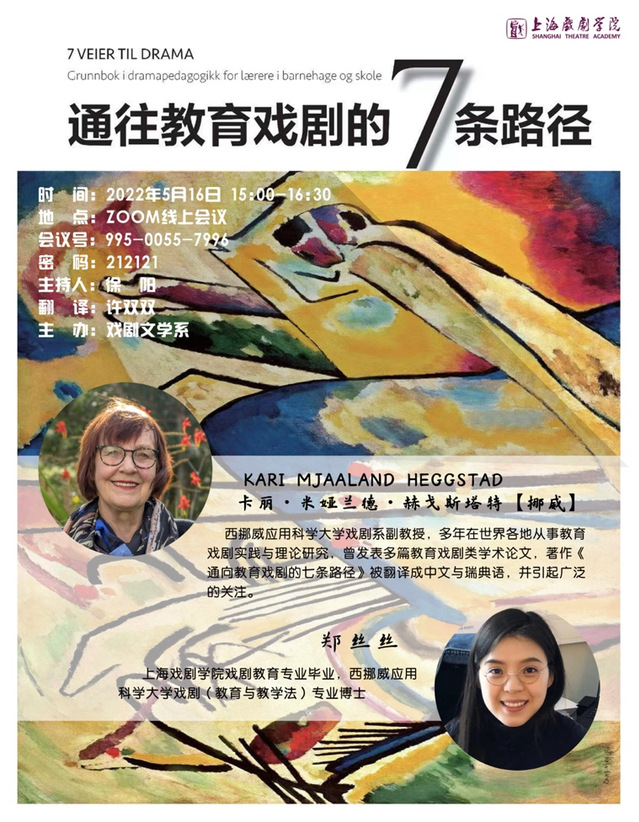为了能够丰富线上教学,拓展同学们的视野,上海戏剧学院戏文系将陆续在线上举办戏剧教育专业系列讲座。

2022年5月16日,第二期讲座由徐阳老师特别邀请到了西挪威应用科学大学戏剧系Kari Mjaaland Heggstad副教授,以及戏剧(教育与教学法)专业的郑丝丝博士,来到线上课堂,与同学们一起分享在教育戏剧实践过程中的经验,并回答了同学们的相关问题。讲座由徐阳老师主持。

Kari Mjaaland Heggstad
西挪威应用科学大学
戏剧系副教授
多年在世界各地从事教育戏剧实践与理论研究
《通往教育戏剧的七条路径》作者

郑丝丝
西挪威应用科学大学
戏剧(教育与教学法)专业博士
Part1
——Kari
Western Norway University of applied sciences has had a connection with Shanghai Theatre Academy since 2003. I will focus on three perspectives that are important for educational drama in practice and list some examples that can be used as ideas or inspirations for your own work.
西挪威应用科学大学和上海戏剧学院从2003年就开始建立联系。我将会讲述三个在教育戏剧实践中重要的方面,列出一些戏例子,可以给你们在工作中有一些启发。
A thinking tool is: How can I facilitate this lesson to include everyone, challenge them, shift perspectives, investigate, explore, to reflect?
需要思考的是:需要如何让每个人都能参与到课程中来,让他们获得挑战、转变思维、去发现、去探索、去思考。
1.Start planning a drama lesson 开始策划一次戏剧课
(1) Pre-texts--examples from the book 文本准备——从书上找到范例
The text chosen should catch the participants' attention, and trigger their curiosity and engagement. The start should create a motivation to find more about what this means and what is at stake. Our whole cultural history can provide exciting pre-texts.
我们选择的文本需要能够吸引参与者的兴趣,激发他们的好奇心和投入。开头需要创造去探索更多其中深意的动力。我们的整个文化历史都可以给我们提供有趣的文本。
·Literature 文学
From this the teacher will either choose a series of events that can be explored or create something new inspired by a particular pre-text. Fairy tales and myths are often pre-texts.
从这之中教师可以选择一系列可以去探索的事件或者创造一些由文本而获得灵感的新内容。童话和神话也经常会被作为文本。
·Visual art 视觉艺术
It's wonderful source we can use. Paintings provide a lot that we explore and move into.
这是我们能够使用的非常好的资源。绘画给我们提供很多我们可以深入探索的内容。
·Music 音乐
Music can create mood and background for drama and speaks to us through the senses. In one class we asked participants to create short scenes of their interpretations of the music and present for each other.
音乐可以为戏剧创造情绪和氛围并且通过感觉与我们对话。在有一堂课中我们让参与者通过对听到的音乐的理解来构建短的场景并且呈现。
·Children's games 儿童游戏
Children love ‘rule games’. This is where they most easily learn rules and consequences when breaking the rules in a natural and exciting way together with other kids.
孩子们很喜欢有规则的游戏,这是一种最简单的方式,能够让他们用本能且有趣的方式和别的孩子一起学习规则和打破规则的后果。
·Objects 物件
Objects can trigger participants' imagination.
物件可以激发参与者的想象力。
(2)The start of the lesson 课程的开始
It's time to invite participants into the drama. Here're some ways you can use it.
这是引导参与者进入戏剧情境的时候。这些方法你们都可以使用。
·Narrative 叙述
·Game 游戏
·Ritual 仪式
·Start without explanation:无引入开始(直接进入戏剧情境)
·Collective drawing 集体绘画
·Create the space with participants 与参与者构建空间
·Listen to a piece of music 听音乐
·Study a painting 认真看一副画
·Prepare the room in a surprising way 用特别的方式布置空间
2. The participants 参与者
When we work through drama, we want the children to experience a given situation-living through it for a while, deal with the implications that are given, and even solve problems. We also want them to reflect and discuss.
在戏剧中,我们希望孩子可以去体会规定情境,在里面投入片刻、体会其中的含义,甚至可以去解决一些问题。我们也希望他们可以思考并讨论。
To make the drama work for the participants, they need to feel safe.
如果要让戏剧为参与者服务,那么他们需要有安全感。
(1) Protection into the role 在角色的保护中
Protection into role means that we adjust the tasks to the maturity and the previous experiences of our group.
进入角色的保护意味着我们要根据参与者的年龄和过去的经历来调整我们的设定。
In Snow White, we started with collective drawing, and let participants think about what the old castle-like.
在工作坊《白雪公主》中,我们从集体绘画开始,让参与者想象古堡的样子。
If there is a child that is timid or afraid of new situations, the child can sit on the side-line and observe in the beginning – and gradually take part.
如果一个孩子比较害羞、害怕新的情境,那么可以坐在一边先来观察开始,再逐渐来参与。
“The penalty-free zone” is part of our protection in drama. We need to make it clear for the children that what you say and do in your role in the drama is the role’s perspective, depending on the situation.
“不受责罚的区域”也是我们在戏剧中保护的一部分。我们需要让孩子清楚,他们在戏剧中的所说所做是基于角色的视角和规定情境。
(2) Collective participatory work 集体参与
When establishing collective roles in big groups, the participants all have the responsibility for investigating together. It is both a responsibility and an opportunity to explore together and inspire each other.
当我们要在很多参与者间构建集体角色时,参与者需要共同来探索。共同探索并且互相启发不仅是个责任,也是一个机遇。
·Collective roles 集体角色
·Moving between roles 角色间的转换
·Moving in and out of the role 在角色内与跳出角色
·Out of the role 在角色外
·Role-to-role 角色对角色
Through these ways, we can let participants work individually through writing or drawing.
在这些方法中我们可以让参与者通过书写或者画画来独自思考。
3. The facilitator's challenge 演教员的挑战
The facilitator should create an exciting and learning experience at the same time.
演教员需要同时创造令人兴奋且具有教育意义的经历。
(1) Signing 指令
It is important how we are signing in the role, if we're not clear, we may confuse the kids.
我们在角色中如何发布指令很重要,如果我们讲得不清晰,我们会让孩子感到困惑。
(2)Seeing and listening 观察和倾听
Besides noticing the active child, we should also listen to the timid child, and notice why some are active in an unattended way to make us laugh.
除了注意到活跃的孩子,我们也要去倾听内向的孩子,注意到一些孩子在情境以外去做一些故意搞笑的行为。
(3)Motivating 激励
The best motivation is presenting interesting material, having a good start, and also following up and supporting the participant along with the work.
最好的激励是要呈现有趣的材料,又一个好的开始,同时也要在工作中跟随并支持着参与者。
(4)Engaging 参与
We should never do a drama lesson we don’t believe in. The first premise is that we have engaged ourselves. Our option is to push our energy button – and be in the drama moment – when we enter the drama lesson.
我们不能做一个我们不相信的戏剧课。首先我们需要让我么自己投入进去。当戏剧课开始的时候,我们需要开启自己的能量来进入戏剧情境。
(5)Flexibility 灵活
Our planning is never perfect, so we should always allow flexibility and be ready to adjust in the process.
我们的策划永远不会是完美的,我们需要灵活地根据情况进行变化,时刻准备进行调整。
Part2
——郑丝丝
关于教育戏剧研究
在研究过程中我们需要明确,想要通过课题去发现的新的知识是什么,教育戏剧是跨学科的,有很多内容都值得研究。确定了这些以后,还要确定我们的工作对象。
现在西方有两个研究的主流方向:
(1)质性研究——研究性质
不太用来研究效果,它包括art research method和art-based research等。
(2)量性研究——数据衡量
用来衡量效果,需要借助特定的研究方法:语汇分析、话语分析法等。受访者的社会背景也需要被明确,如果研究有侧重,则需要把各方面的背景和影响因素都考虑进去。
郑丝丝博士提到,研究中她采取了empirical study的方法开展研究,并通过录像等手段在已有的数据基础上去分析。在挪威做科研是一个不知道终点的事情,开始只是拥有一个想要去探索的领域,但最后是什么结果要做出来才知道,如果知道结果就是反证实验了。所以,逻辑上要转换过来。
Q&A
Q1
想请问两位老师,在挪威的教育戏剧专业本科的课程里,心理学的课程是如何设置的?
在西挪威应用科学大学的本科教学中,对教育学课程的学习会持续半年的时间,但并没有特别开设心理学课程。关于心理学的应用是结合在教育戏剧教学中进行的。
Q2
请问英国的教育戏剧与挪威的教育戏剧有何不同?
我们和英国有很多的联系,在挪威不同的地区有不同的传统,西挪威受英国教育剧场理念的影响很深,并在这个基础上发展。但挪威在进行过程戏剧的节奏上会更慢一些,我们想给予孩子更多探索的时间。
Q3
因为在中国Game和Play都可以翻译作游戏,是否可以说明一下Game与Play两个概念的区别?
Game的概念是指建立在规则上的玩,而Play的概念更多的是和戏剧、表演有关。孩子在整个成长过程中都会经历游戏,成年人也一样。很多时候,两个概念有模糊相似的地方。
Q4
有很多工作坊可能会涉及到悲伤的故事,或者负面情绪。这有可能会刺激到孩子,我们应该如何保护好他们?
戏剧可以帮助我们使用假设,用另外的文本去探索实际的问题。我们可以选择一个负面主题的故事,避免在过程中针对到任何一个学生,而是为孩子创造可以探索如何去解决类似霸凌、孤立等问题的情境。
戏剧可以让我们去触及到我们所担心的一些禁忌,老师的任务是保护参与者,知道正在发生的事。首先,在确定工作对象年龄的前提下,了解他们的需求和已经发展出来的能力。其次,演教员要相信孩子们。在操作的过程中关注孩子的反馈,随时根据孩子的反应来作流程的调整。演教员可以随时决定是否继续深入探索下去,还是就此打住。
Q5
如何衡量既能维持故事框架又让参与者有开放的选择?
现场实践的内容和文本差的很多并不会让人觉得是一个不好的工作坊,我们要先去接纳这个不同。我们可以去思考:你希望参与者们每次体验的是同一个故事吗?故事在被创作的年代和现在被引起的讨论是同一个话题吗?
并且,我们要找到另一种解读材料的方式,找到我们可以和孩子在戏剧中共同探索的元素。我们可以用另一种视角来看待故事,就像在《穿条纹睡衣的男孩》中我们可以聚焦布鲁诺这个角色,他如何冲破父亲带来的束缚,而不是被烧死的结果。我们需要给到足够的空间,比如让每个参与者可以进入到布鲁诺到角色来体验。
Q6
在现代社会,孩子们被手机影响,我们要如何做才能帮助他们保持注意力的集中?
这与戏剧老师的方法息息相关,包括:和参与者的联系,是否令人激动,是否有参与性,参与者之间的联系是否紧密等等,参与的越深,得到的越多……同时,你也需要成为一个很好的戏剧编剧,使得参与者能够很兴奋地投入其中。我接触教育戏剧几十年了,但我仍然在学习,我们需要时刻发现可以做出改变的地方。在挪威孩子们在进入课堂的时候不会单独拥有手机,它们会统一保管在一个盒子里,所以我们并不被这个情况困扰,在我们进行戏剧的时候不应该让附近有手机出现。
(图/文整理:叶宇辰)

